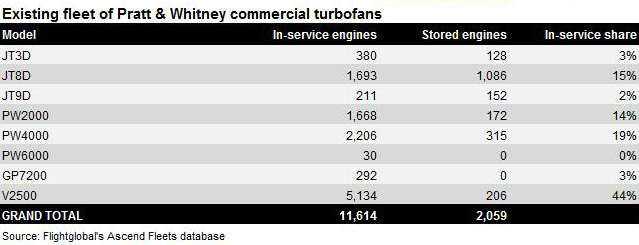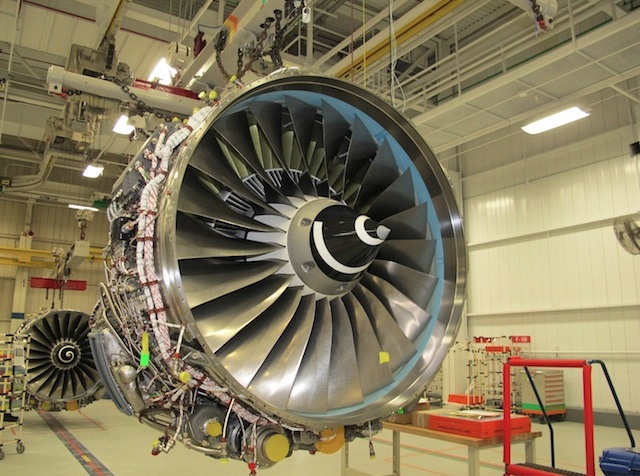As Pratt & Whitney’s business shifts from large commercial engines to small and medium-sized ones, the manufacturer is expecting its aftermarket business to expand significantly.
When the number of engines made by Pratt &Whitney peaked in the 1990s, the vast majority of that fleet comprised the manufacturer’s own powerplants, such as the PW2000, PW4000, and legacy JT8D and JT9D models. Flightglobal’s Ascend Fleets database shows that the in-service fleet reached nearly 16,200 units in 1998, while the manufacturer’s International Aero Engines joint venture with Rolls-Royce, Japanese Aero Engines and MTU made up an approximately 5% share via the V2500 series.
But with the increase in Airbus’s A320 production, the V2500 has become the single most important engine programme in the existing fleet. While they could not compensate the decline in Pratt & Whitney’s legacy fleet, rising V2500 deliveries slowed the overall reduction in the manufacturer’s installed commercial engine base.
Today, that decline has reached a trough, with the V2500 having a 44% share in the existing, approximately 11,600-strong in-service fleet. By the end of the decade, the fleet is projected to surpass its 1998 peak through the V2500 backlog and ramp-up of the successor PW1000G geared turbofan programme.

As Pratt & Whitney has commitments for another 2,000 V2500s and 6,000 PW1000G series powerplants today, the manufacturer expects its commercial engine production to grow more than 60% between 2013 and 2018. But while the V2500 production will largely wind down as Airbus transitions from current-generation A320s to the re-engined A320neo series between 2015 and 2018, Pratt & Whitney’s growth will be entirely driven by the PW1000G programme for regional and narrowbody aircraft. V2500 deliveries will continue thereafter, at a much reduced volume, for the in-development Embraer KC-390 military transport.
Aside from the A320neo, variants of the geared turbofan have been selected to power the Bombardier’s CSeries, Embraer’s next E-Jet generation, the Mitsubishi Regional Jet, and Russia’s Irkut MC-21 narrowbody family, which are all in development at one stage or another.

The new focus on small and medium-sized engines is in stark contrast to the 1990s, when Pratt & Whitney engines were employed to power Airbus and Boeing widebodies up to the respective A330 and 777 models. With the exception of the Engine Alliance GP7200 engine – a partnership with General Electric to power the A380 – the manufacturer is not supplying engines for the future long-haul families of Airbus and Boeing.
As it has been squeezed out of the widebody segment by GE and Rolls-Royce, Pratt & Whitney is banking on the regional aircraft arena for future growth, in addition to continuing the supply of engines for the A320 programme. ”That [regional market] is an entirely new segment for us. So we see tremendous OE [original equipment manufacturing] growth in front of us,” says aftermarket president Matthew Bromberg.
Aerospace suppliers will benefit from an “almost unprecedented” growth cycle as airlines in emerging markets expand their fleets, while carriers in the mature regions of Europe and North America are replacing aircraft, he says. Pratt & Whitney expects its installed engine base to grow 5-6% a year.
Meanwhile, the fleet is growing younger, providing more scope for aftermarket business. While the legacy PW2000s and PW4000s have an average age of 18 years, the existing V2500 fleet stands at eight years, says Bromberg. Thus the focus will shift from an installed base that is predominantly comprised of engines in their third and final lifecycle phase – the sunset period when they are retired and availability of spare equipment rises – to a fleet “that is just entering the prime part of their operating life, the second decade”, he says.
Apart from increased demand for overhauls, spare parts and component repairs to keep the fleet in the air, it is the engine manufacturers’ growing aftermarket control that is driving their MRO business. While around 45% of PW4000 engines have been serviced through flight-hour-based maintenance programmes by the manufacturer, that share has risen to 60% on the V2500 series and is targeted to reach 80% for the PW1000G geared turbofan, says Pratt & Whitney.

Pratt & Whitney V2500
This is in addition to engines maintained by the manufacturer through individually arranged MRO activities. Aside from the PW4000s under flight-hour-based contracts, Pratt & Whitney conducts another 20% of all overhauls for that type on a transactional basis, says Bromberg. Meanwhile, the OEM also supplies third-party overhaul shops with spare parts, and controls the provision of technical know-how through the sale of repair licences.
Bromberg argues that Pratt & Whitney is pursuing an aftermarket strategy that allows operators to service engines in their own facilities or through third-party MRO specialists. “Choice is good for the customers because it ensures they can compare us [with other service providers],” he says. Several new overhaul shops that are at least part-owned by airlines will open over the next decade, especially in emerging markets, he expects. While these facilities will primarily focus on their own fleet requirements, “any shop could be a third-party shop and so there will be more and more choice in the marketplace”, he adds.
However, Bromberg also argues that manufacturers are by definition more efficient than independent competitors due to the scale of their aftermarket operations and flexibility of international maintenance capacity: “When you are the OEM and you are managing 60-plus per cent of the overhauls, you can be far more efficient than any single shop could ever be.”
The scale of the manufacturers’ operations and their immediate access to technical know-how and spare parts allows them to offer hour-based full-support agreements. Services such as spare engine provisioning, inventory planning, engine asset management and insurance against operational disruptions have become more popular with airlines as they aim to limit financial risks and focus on their operations. But this excludes most third-party MRO specialists from competing for contracts. “They can provide a maintenance solution, but they sure cannot provide risk reduction, insurance and fleet optimisation,” says Bromberg. “They are not geared for that.”
While the PW1000G programme is set to sustain Pratt & Whitney’s standing in the commercial engine arena in future, it is the predecessor V2500 model that will drive the aftermarket business. Rolls-Royce’s departure from IAE in 2012 – the UK-based founding member sold its 32.5% stake to Pratt & Whitney – was a crucial step for the US manufacturer to support its maintenance business amid the decline in the legacy fleet. “The Rolls-Royce acquisition was game-changing for Pratt & Whitney’s aftermarket [business], because it provided us with the volume and focus on the V[2500] programme, which we need for the next decade until the geared turbofan picks up in volume,” says Bromberg.
Rolls-Royce continues to service V2500s at its facilities, but this is done in a subcontractor role, with Pratt & Whitney managing the aftermarket support programme. While the existing V2500 fleet generates around 800 shop visits per annum, this is set to increase around 50% over the next six years.
The PW1000G fleet will be supported from some of the existing V2500 overhaul facilities. As scheduled shop visits are not due to begin for about five years after the planned entry-into-service on the A320neo and CSeries in late 2015, repair and overhaul capabilities will initially be established at a manufacturer facility to complete any warranty MRO work. Bromberg says that while Pratt & Whitney has finalised plans for the shop layout and has even ordered tooling to service the new engine generation, it has not yet decided where the first shop will be located.
That is to be determined over the next year, he says. It is understood that PW1000G support capabilities will be gradually rolled out to a limited number of V2500 shops. But Bromberg says that “as the [fleet] volume grows, we will bring additional network partners either through airline-dedicated shops or potentially independent shops... Not everyone wants to go to Pratt & Whitney, and we respect that. We want to make sure there is a flexible response in the network so that they [operators] can have choice.”
Source: Cirium Dashboard
















